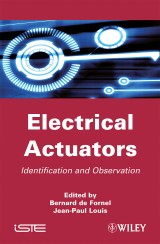Details

Electrical Actuators
Applications and Performance1. Aufl.
|
181,99 € |
|
| Verlag: | Wiley |
| Format: | |
| Veröffentl.: | 04.03.2013 |
| ISBN/EAN: | 9781118586280 |
| Sprache: | englisch |
| Anzahl Seiten: | 528 |
DRM-geschütztes eBook, Sie benötigen z.B. Adobe Digital Editions und eine Adobe ID zum Lesen.
Beschreibungen
<p>The different chapters of this book cover a large range of information regarding electrical actuators, including: synchronous and asynchronous machine modeling in order to measure and identify offline and online parameters using modern optimization methods; identification in real time of parameters with Luenberger filter and the extended Kalman filter; estimation of non-measurable variables, first by linear estimates and observers, then by lower observers. Robustness is a very problematic issue, as well, which is fully explored in a chapter dedicated to the subject. Finally, the estimate of non-measurable mechanical variables is particularly dealt with: estimate of load moment, then observation of the positioning of a command without mechanical sensor. The conditions to measure variables and real implementation of numerical algorithms are also examined with particular attention.</p>
<p><b>Introduction xiii</b><br /> <i>Bernard DE FORNEL and Jean-Paul LOUIS</i></p> <p><b>PART I. MEASURES AND IDENTIFICATIONS 1</b></p> <p><b>Chapter 1. Identification of Induction Motor in Sinusoidal Mode 3</b><br /> <i>Edouard LAROCHE and Jean-Paul LOUIS</i></p> <p>1.1. Introduction 3</p> <p>1.2. The models 4</p> <p>1.3. Traditional methods from a limited number of measurements 17</p> <p>1.4. Estimation by minimization of a criteria based on admittance 24</p> <p>1.5. Linear estimation 36</p> <p>1.6. Conclusion 44</p> <p>1.7. Appendix 45</p> <p>1.8. Bibliography 47</p> <p><b>Chapter 2. Modeling and Parameter Determination of the Saturated Synchronous Machine 49</b><br /> <i>Ernest MATAGNE and Emmanuel DE JAEGER</i></p> <p>2.1. Modeling of the synchronous machine: general theory 49</p> <p>2.2. Classical models and tests 83</p> <p>2.3. Advanced models: the synchronous machine in saturated mode 100</p> <p>2.4. Bibliography 116</p> <p><b>Chapter 3. Real-Time Estimation of the Induction Machine Parameters 119</b><br /> <i>Luc LORON</i></p> <p>3.1. Introduction 119</p> <p>3.2. Objectives of parameter estimation 121</p> <p>3.3. Fundamental problems 124</p> <p>3.4. Least square methods 138</p> <p>3.5. Extended Kalman filter 146</p> <p>3.6. Extended Luenberger observer 158</p> <p>3.7. Conclusion 168</p> <p>3.8. Appendix: machine characteristics 169</p> <p>3.9. Bibliography 169</p> <p><b>PART II. OBSERVER EXAMPLES 175</b></p> <p><b>Chapter 4. Linear Estimators and Observers for the Induction Machine (IM) 177</b><br /> <i>Maria PIETRZAK-DAVID, Bernard DE FORNEL and Alain BOUSCAYROL</i></p> <p>4.1. Introduction 177</p> <p>4.2. Estimation models for the induction machine 178</p> <p>4.3. Flux estimation 186</p> <p>4.4. Flux observation190</p> <p>4.5. Linear stochastic observers—Kalman–Bucy filters 198</p> <p>4.6. Separate estimation and observation structures of the rotation speed 210</p> <p>4.7. Adaptive observer 223</p> <p>4.8. Variable structure mechanical observer (VSMO) 234</p> <p>4.9. Conclusion 248</p> <p>4.10. Bibliography 249</p> <p><b>Chapter 5. Decomposition of a Determinist Flux Observer for the Induction Machine: Cartesian and Reduced Order Structures 251</b><br /> <i>Alain BOUSCAYROL, Maria PIETRZAK-DAVID and Bernard DE FORNEL</i></p> <p>5.1. Introduction 251</p> <p>5.2. Estimation models for the induction machine 252</p> <p>5.3. Cartesian observers 260</p> <p>5.4. Reduced order observers 271</p> <p>5.5. Conclusion on Cartesian and reduced order observers 281</p> <p>5.6. Appendix: parameters of the study induction machine 281</p> <p>5.7. Bibliography 281</p> <p><b>Chapter 6. Observer Gain Determination Based on Parameter Sensitivity Analysis 285</b><br /> <i>Benoît ROBYNS</i></p> <p>6.1. Introduction 285</p> <p>6.2. Flux observers 286</p> <p>6.3. Analysis method of the parametric sensitivity 293</p> <p>6.4. Choice of observer gains 298</p> <p>6.5. Reduced order flux observer 301</p> <p>6.6. Full order flux observer 310</p> <p>6.7. Conclusion 316</p> <p>6.8. Appendix: parameters of the squirrel-cage induction machine 319</p> <p>6.9. Bibliography 319</p> <p><b>Chapter 7. Observation of the Load Torque of an Electrical Machine 321</b><br /> <i>Maurice FADEL and Bernard DE FORNEL</i></p> <p>7.1. Introduction 321</p> <p>7.2. Characterization of a load torque relative to an axis of rotation 322</p> <p>7.3. Modal control of the actuator with load torque observation 330</p> <p>7.4. Observation of load torque 342</p> <p>7.5. Robustness of control law by state feedback with observation of the resistant torque 377</p> <p>7.6. Experimental results 386</p> <p>7.7. Conclusion 399</p> <p>7.8. Bibliography 401</p> <p><b>Chapter 8. Observation of the Rotor Position to Control the Synchronous Machine without Mechanical Sensor 405</b><br /> <i>Stéphane CAUX and Maurice FADEL</i></p> <p>8.1. State of the art 405</p> <p>8.2. Reconstruction of the low-resolution position 409</p> <p>8.3. Exact reconstruction by redundant observer 414</p> <p>8.4. Exact reconstruction by Kalman filter 436</p> <p>8.5. Comparison of reconstructions by Kalman filter or analytical redundancy observer 451</p> <p>8.6. Bibliography 458</p> <p><i>List of Authors 461</i></p> <p><i>Index 463</i></p>
<p><strong>Bernard de Fornel</strong> works for ENS Cachan, France. <p><strong>Jean-Paul Louis</strong> works for ENSEEIHT, Toulouse, France.


















